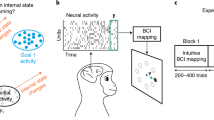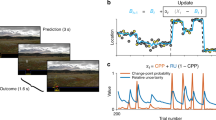Abstract
The present paper takes a first step toward the integration of recent findings on brain dynamics and learning into established fields of psychophysiological science.
Leading-edge studies of brain dynamics have shown that the brain manifests an inherent variability and that, when new stimuli (i.e., “problems”) are presented to the organism, brain chaos increases.
Similarly, many previous studies using a wide variety of physiological and behavioral measures have shown that “psychophysiological uncertainty” is associated with novel stimuli, novice behavioral performance, and new stimulus-stimulus and response-stimulus contingencies. Such uncertainty may ultimately be resolved through some form of learning.
Along with the general changes in physiological and behavioral activity, increases in brain chaos may usher the organism into an exploratory mode which serves as a catalyst for learning.
Similar content being viewed by others
References
Andreassi, J.L. (1989).Psychophysiology: Human Behavior and Physiological Response. Hillsdale, NJ: Lawrence Erlbaum.
Barry, R.J. (1987). Preliminary processes in orienting response elicitation. In P.K. Ackles, J.R. Jennings and M.G.H. Coles (Eds.),Advances in Psychophysiology (Volume 2). Greenwich, CT: JAI Press.
Basar, E. (1976).Biophysical and Physiological Systems Analysis. Reading, MS: Addison-Wesley.
Bernstein, A.S. (1969). To what does the orienting response respond?Psychophysiology, 6: 338–350.
Brener, J. (1987). Behavioral energetics: Some effects of uncertainty on the mobilization and distribution of energy.Psychophysiology, 24: 499–512.
D’Amato, M.R., Etkin, M. and Fazzaro, J. (1968). Cue-producing behavior in the Capuchin monkey during reversal, extinction, acquisition, and overtraining.Journal of Experimental Psychology, 77: 425–433.
Davies, P. (1988).The Cosmic Blueprint. New York, NY: Touchstone.
Germana, J. (1968a). Response characteristics and the orienting reflex.Journal of Experimental Psychology, 78: 610–616.
Germana, J. (1968b). Psychophysiological correlates of conditioned response formation.Psychological Bulletin, 70: 105–114.
Germana, J. (1969). Central efferent processes and autonomic-somatic integration.Psychophysiology, 6: 78–90.
Germana, J. (1973). Psychophysiology of learning and conditioning. In F.J. McGuigan and D.B. Lumsden (Eds.),Contemporary Approaches to Conditioning and Learning. New York, NY: Wiley.
Germana, J. (1986). A systems view of the orienting reflex.Pavlovian Journal of Biological Science, 21: 65–66.
Germana, J. (1989). The biological significance of behavioral learning from a systems view.Behavioral Science, 34: 228–237.
Gibson, J.J. (1986).The Ecological Approach to Visual Perception. Hillsdale, NJ: Lawrence Erlbaum.
Gleick, J. (1987).Chaos: Making a New Science. New York, NY: Penguin Books.
Groves, P.M. and Thompson, R.F. (1970). Habituation: A dual-process theory.Psychological Review, 77: 419–450.
Hamlin, P.H. (1972). Observing responses as an index of attention in chickens. Unpublished doctoral dissertation, Rutgers University, New Brunswick, NJ.
Laszlo, E. (1972).Introduction to a Systems Philosophy. New York, NY: Harper and Row.
Latash, L.P. (1990). Orienting reaction, organizing for action, and emotional responses.Pavlovian Journal of Biological Science, 25: 123–131.
Lynn, R. (1966).Attention, Arousal and the Orientation Reaction. New York, NY: Pergamon.
Maltzman, I. (1987). OR theory: Promise unfulfilled. In P.K. Ackles, J.R. Jennings and M.G.H. Coles (Eds.),Advances in Psychophysiology (Volume 2). Greenwich, CT: JAI Press.
Maltzman, I. (1990). The OR and significance.Pavlovian Journal of Biological Science, 25: 111–122.
McAuliffe, K. (1990). Get smart: Controlling chaos.Omni, 12: 42–86.
Muenzinger, K.F. (1938). Vicarious trial and error at a choice point: I. A general survey of its relation to learning efficiency.Journal of General Psychology, 53: 75–86.
Mitra, M. and Skinner, J.E. (1992). Low-dimensional chaos maps learning in a model neuropil.Integrative Physiological and Behavioral Science, 27: 304–322.
Molnar, M. and Skinner, J.E. (1992). Low-dimensional chaos in event-related brain potentials.International Journal of Neuroscience, 66: 263–276.
Nicolis, G. and Prigogine, I. (1977).Self-organization in nonequilibrium systems. New York, NY: Wiley.
Nicolis, J.S. and Benrubi, M. (1975). A model on the role of noise at the neuronal and cognitive levels. In J. Rose and C. Bilciu (Eds.),Modern Trends in Cybernetics and Systems (Volume III). Berlin: Springer-Verlag.
Notterman, J.M. and Mintz, D.E. (1965).Dynamics of Response. New York, NY: Wiley.
Ohman, A. (1979). The orienting response, attention, and learning: An information-processing perspective. In H.D. Kimmel, E.H. van Olst and J.F. Orlebeke (Eds.),The Orienting Reflex in Humans. New York, NY: Wiley.
Pavlov, I.P. (1927).Conditioned Reflex. New York, NY: Dover.
Pavlov, I.P. (1928).Lectures on the Conditioned Reflexes. New York, NY: International Press.
Prigogine, I. (1980).From Being to Becoming. San Francisco, CA: Freeman.
Prigogine, I. and Allen, P.M. (1982). The challenge of complexity. In W.C. Schieve and P.M. Allen (Eds.),Self-organization and Dissipative Structures. Austin, TX: University of Texas Press.
Prigogine, I. and Stengers, I. (1984).Order Out of Chaos. Boulder, CO: New Science Library.
Prokasy, W.F. (1972). Developments with the two-phase model applied to human eyelid conditioning. In A.H. Black and W.F. Prokasy (Eds.),Classical Conditioning II:Current Research and Theory. New York, NY: Appleton-Century-Crofts.
Rapp, P.E. (1993). Chaos in the neurosciences: Cautionary tales from the frontier.Biologist, 40(2): 89–94.
Rapp, P.E. (1994). A guide to dynamical analysis.Integrative Physiological and Behavioral Science, 29: 311–327.
Rapp, P.E. (in press). Is there evidence for chaos in the human central nervous system? In R. Robertson and A. Combs (Eds.),A Chaos Psychology Reader. Hillsdale, NJ: Lawrence Erlbaum.
Rapp, P.E., Bashore, T., Martinerie, J., Zimmerman, I., Albano, A. and Mees, A. (1989). Dynamics of brain electrical activity.Brain Topography, 2: 99–118.
Schwartz, B. (1988). The experimental synthesis of behavior: Reinforcement, behavioral stereotypy, and problem solving. In G.H. Bower (Ed.),The Psychology of Learning and Motivation (Volume 22). New York, NY: Academic Press.
Skarda, C. and Freeman, W. (1987). How brains make chaos in order to make sense of the world.Behavioral and Brain Science, 10: 161–195.
Skinner, J.E. (1994). Postscript.Integrative Physiological and Behavioral Science, 29(3): 334–337.
Skinner, J.E., Molnar, M. and Tomberg, C. (1994). The point-correlation dimension: Performance with nonstationary surrogate data and noise.Integrative Physiological and Behavioral Science, 29(3): 217–234.
Sokolov, E.N. (1963).Perception and the Conditioned Reflex. New York, NY: Pergamon.
Sokolov, E.N. (1990). The orienting response, and future directions of its development.Pavlovian Journal of Biological Science, 25: 142–150.
Sokolov, E.N. and Vinogradova, O.S. (1975).Neuronal Mechanisms of the Orienting Reflex. Hillsdale, NJ: Lawrence Erlbaum.
Stein, L. (1966). Habituation and stimulus novelty: A model based on classical conditioning.Psychological Review, 73: 352–356.
Stern, J.A. (1972). Physiological response measures during classical conditioning. In N.S. Greenfield and R.A. Sternbach (Eds.),Handbook of Psychophysiology. New York, NY: Holt, Rinehart and Winston.
Stern, R.M., Ray, W.J. and Davis, C. (1980).Psychophysiological Recording. New York, NY: Oxford University Press.
Thomas, G.J. (1962). Neurophysiology of learning.Annual Review of Psychology, 13: 71–106.
Thompson, R.F., Berry, S.D., Rinaldi, P.C., and Berger, T.W. (1979). Habituation and the orienting reflex: The dual-process theory revisited. In H.D. Kimmel, E.H. van Olst and J.F. Orlebeke (Eds.),The Orienting Reflex in Humans. Hillsdale, NJ: Lawrence Erlbaum.
Thompson, R.F., Clark, G.A., Donegan, N.H., Lavond, D.G., Lincoln, J.S., Madden, J., Mamounas, L.A., Mauk, M.D., McCormick, D.A. and Thompson, J.K. (1984). Neuronal substrates of learning and memory: A “multiple-trace” view. In G. Lynch, J.L. McGaugh and N.M. Weinberger (Eds.),Neurobiology of Learning and Memory. New York, NY: Guilford.
Thompson, R.F. and Glanzman, D.L. (1976). Neural and Behavioral mechanisms of habituation and sensitization. In T.J. Tighe and R.N. Leaton (Eds.),Habituation. Hillsdale, NJ: Lawrence Erlbaum.
Thompson, R.F., Patterson, M.M. and Teyler, T.J. (1972). The neurophysiology of learning.Annual Review of Psychology, 23: 73–104.
Thompson, R.F. and Spencer, W.A. (1966). Habituation: A model phenomenon for the study of neuronal substrates of behavior.Psychological Review, 73: 16–43.
Tolman, E.C. (1938). The determiners of behavior at a choice point.Psychological Review, 45: 1–41.
Tolman, E.C. (1939). Prediction of vicarious trial and error by means of a schematic sowbug.Psychological Review, 47: 318–336.
Tolman, E.C. (1948). Cognitive maps in rats and men.Psychological Review, 55: 189–208.
van Olst, E.H., Heemstra, M.L. and ten Kortenaar, T. (1979). Stimulus significance and the orienting reaction. In H.D. Kimmel, E.H. van Olst and J.F. Orlebeke (Eds.),The Orienting Reflex in Humans. Hillsdale, NJ: Lawrence Erlbaum.
von Bertalanffy, L. (1968).General System Theory. New York, NY: George Braziller.
Weinberger, N.M., Diamond, D.M. and McKenna, T.M. (1984). Initial events in conditioning: Plasticity in the pupillomotor and auditory systems. In G. Lynch, J.L. McGaugh and N.M. Weinberger (Eds.),Neurobiology of Learning and Memory. New York, NY: Guilford.
Wong, P.T.P. (1977). A behavioral field approach to instrumental learning in the rat: I. Partial reinforcement effects and sex differences.Animal Learning and Behavior, 5: 5–13.
Wong, P.T.P. (1978). A behavioral field approach to instrumental learning in the rat: II. Training parameters and a stage model of extinction.Animal Learning and Behavior, 6: 82–93.
Yao, Y. and Freeman, W. (1990). Model of biological pattern recognition with spatially chaotic dynamics.Neural Networks, 3: 153–170.
Author information
Authors and Affiliations
Rights and permissions
About this article
Cite this article
Germana, J., Lancaster, R. Brain dynamics, psychophysiological uncertainty and behavioral learning. Integrative Physiological and Behavioral Science 30, 138–150 (1995). https://doi.org/10.1007/BF02691682
Issue Date:
DOI: https://doi.org/10.1007/BF02691682




